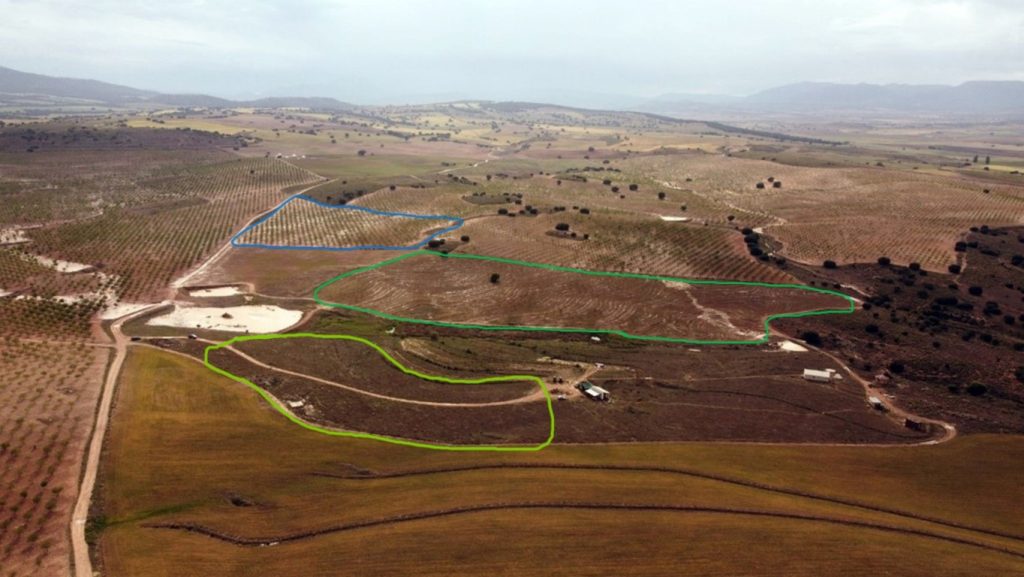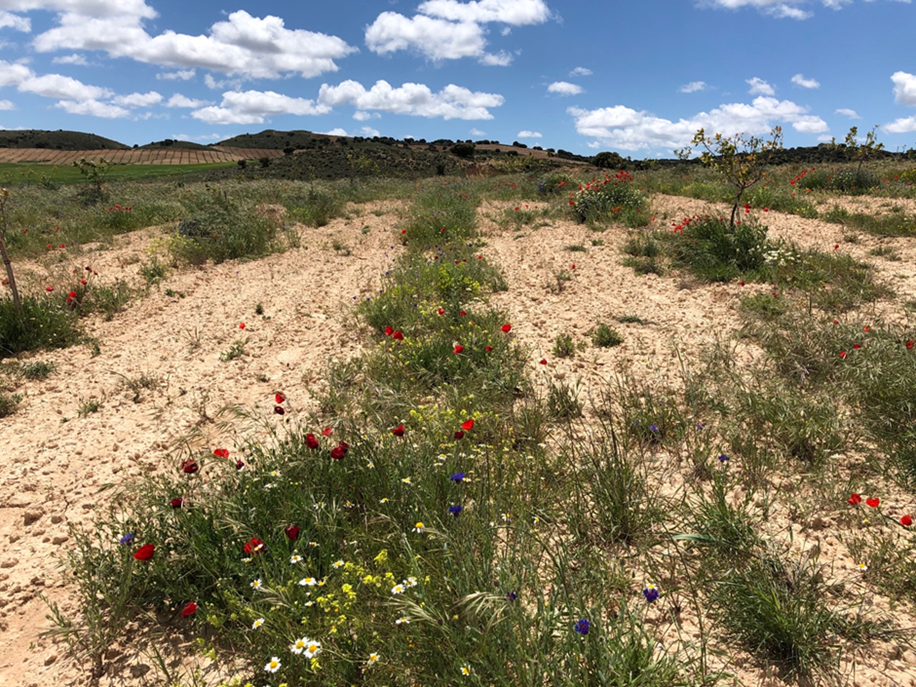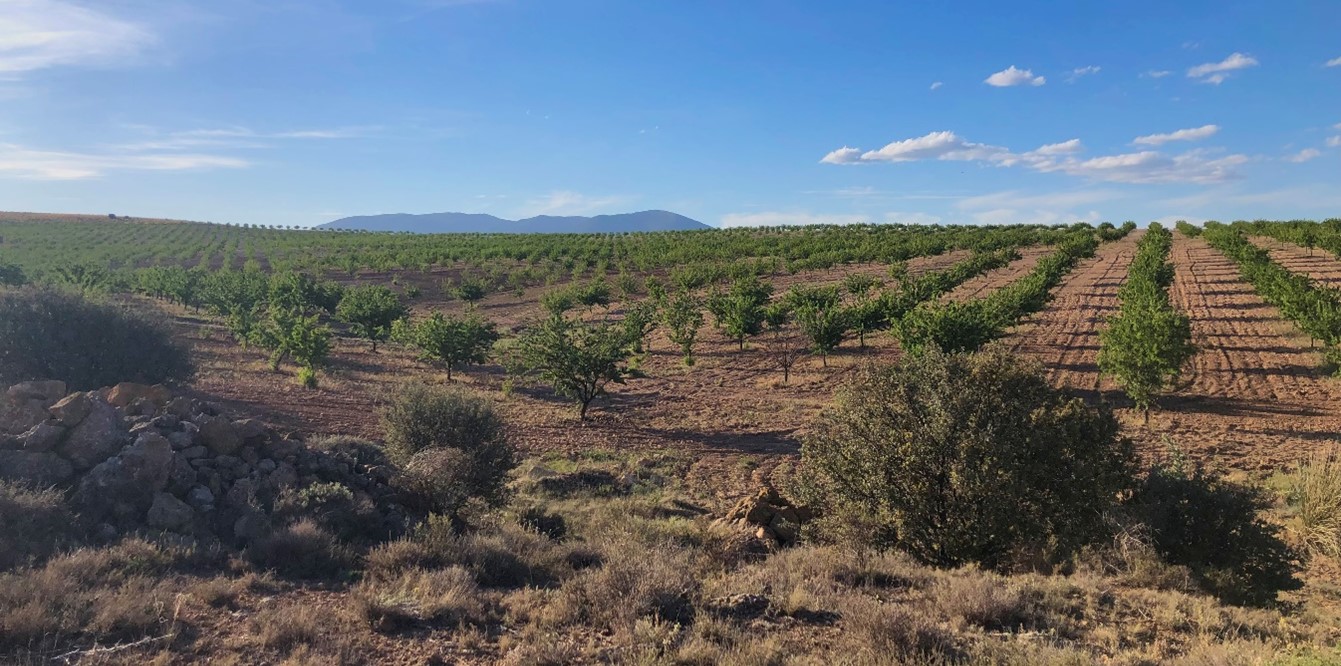Optimizing Water Retention in Almond Orchards: Comparing Contour, Keyline, and Conventional Designs
Cover image: Conventional almond fields of La Junquera. Photo by Deniz Erkan.
Water retention is crucial for crop production in semi-arid lands, especially on slopes where water runoff is a major issue. Water runoff is a significant threat to farmers as it can trigger soil erosion, leading to land degradation and reduced productivity (Issaka & Ashraf, 2017).
This article compares soil moisture levels in three almond orchard designs:
- Contour line plantings: Almonds planted along contour lines with vegetation cover.
- Keyline design: Almonds planted using keyline principles with vegetation strips of 1m.
- Conventional planting design: A control plot with a square plantation (7m x 7m) and no ground cover, typical for the Murcia region in Spain.
Additionally, the article evaluates the benefits of these water retention-focused designs with more examples. If you are a farmer starting a new orchard in an arid region, this article is for you!
How to select the best planting design in an almond orchard
We will start with the experimental work and highlight the importance of plantation designs. The article includes both structural practices and simpler methods to help you maximize water retention. This is particularly important for sloped fields in arid areas where water is a limited resource.
Experimental Work on Plantation Designs for Water Retention on Slopes
This section is based on a small-scale study of the regenerative farm of La Junquera in Murcia, Spain. The experimental plots consist of three different management systems:
- RAN (regenerative agriculture, no-tillage)
- Almonds planted on contour lines with around 7 meters between lines/trees,
- No-tillage,
- Full ground cover (mix of 35 species seeded when trees were planted).
- RAC (regenerative agriculture, conservation tillage)
- Almonds planted on key-line design, around 7 meters between lines/trees,
- Permanent vegetation strips of around 1.5 meters in the middle,
- Tilled 3 times a year around the trees in the summer season.
- OT (organic tillage) / Conventional
- Almonds planted in straight lines with around 7 meters between lines/trees,
- Managed organically,
- The entire field is tilled 7-8 times a year – no ground cover
Soil moisture content measurements at the top and bottom of the slope were taken to test for significant differences, allowing us to detect water retention efficiency in each plot. There was around 10 meters difference in altitude between the top and bottom of each field. In total, 144 measurements were taken, 48 per plot, 24 per slope top, and the slope bottom.
Results
- Significant differences between slope top and slope bottom in the Keyline and Conventional plots,
- Contour plot performed the best at water retention, followed by Keyline,
- The conventional plot had the worst water retention.
The difference in moisture content seen in the Keyline plot is likely due to water runoff from the adjacent conventional field, making the bottom of the slope wetter (Images 2 & 3). This is supported by nearly identical moisture levels at the top of both Contour and Keyline plots (Table 1).

Table 1: Results of soil moisture content data analysis and interpretation.
Additionally, if we refer back to the management methods of each plot, we can see that the contour plot has a complete ground cover while the keyline only has vegetation strips between the rows of trees. Although ground cover can benefit water retention, it also consumes some available water, leaving less water for the crops, which can be problematic in dry years (Ding et al., 2024).
In conclusion, contour performed the best according to the presented results; nevertheless, keyline design is induced to be equally effective at water retention. Meanwhile, conventional plantation design is the most ineffective at water retention on slopes.

Image 2: Landscape view of the three experimental plots of La Junquera, Spain. The plot marked with blue is conventional; light green is contour, and dark green is the Keyline plot—photo by Casper Roosenboom.

Image 3: Close of the Keyline design showing the influx of water from the nearby conventional field, which flows into the slope bottom of the Keyline plot. Photo by Casper Roosenboom.
Things to Consider When Starting An Orchard
In the previous section, we saw some results; now, the question is how we can use these findings to implement them into practice.
Firstly, observing and inspecting the land you want to start your orchard is essential. Just as we saw in the results of the experimental work, the surrounding area and the environmental factors greatly influence how each design will perform in terms of water retention. It is a common mistake to plant orchards without properly evaluating the landscape. Unlike cereals and vegetable crops, trees are a long-term project. They take years to become productive, and planting them is always an investment. Furthermore, with the increasing climatic challenges, preventive measures can save you a lot of money.
Other Measures to Improve Water Retention on Sloped Orchards
By now, we know that planting your orchard on contour or in keyline design can drastically improve water retention on sloped fields and reduce topsoil erosion. Next, we will consider other practices that play a role in water retention.
- Vegetation cover:
In the previous section, we touched upon the impact of ground vegetation cover; it can be a beneficial measure to help the infiltration and retention of water, but the vegetation cover also consumes water, which can be problematic in areas where water is already a limiting factor (Ding et al., 2024; Liu et al., 2021; Wei et al., 2019). Once the trees have established deep roots and reached maturity (around 5 years for most fruit trees, including almonds), this competition for water is less critical (Ding et al., 2024; Fang et al., 2021). However, in the earlier years of the tree, full ground cover can result in limited growth and delay productive maturity (Ding et al., 2024; Fang et al., 2021; Merwin & Stiles, 1994). This is also visible in our experimental plots, where the almond trees of the contour plot (full ground cover) are significantly smaller than the ones in the keyline plot (vegetation strips), even though they were planted at the same time in 2019 (image 3). Therefore, it is wise to slowly increase the ground cover of your orchards, starting from thin strips and increasing the area of vegetation cover.

Image 4: This picture showcases a vegetation strip of around 1.5 meters in a pistachio plot on La Junquera farm, with trees planted 7m x 7m apart. Photo by Regeneration Academy.
- Terracing:
Although not included in this study, terracing also increases soil moisture content effectively (Wei et al., 2019; Xu et al., 2021). However, its cost- and labor-intensive application makes it less desirable for farmers. Hence, natural terrace formation through contour planting of trees, ground cover, or plowing can be preferable (Do et al., 2023).
- Swales:
Swales can be incorporated into your contour plantations to capture water and slowly infiltrate it into the soil at an angle. Setting up flood control reservoirs can also help prevent severe damage in orchards in case of flood events. All of these practices must be applied before planting an orchard, once again highlighting the importance of assessing and designing your land before plantation. There are, of course, practices that can be implemented post-plantation to increase water retention, such as mulching and cover cropping. However, the best-case scenario would be a combination of these measures.

Image 5: Example of a swale in a cereal field on La Junquera farm. Photo by Regeneration Academy.
To conclude, there are many ways to improve soil moisture content and water retention in your orchards. Contour and keyline planting are good ways to avoid erosion and redistributing rainwater in your fields. Nevertheless, many factors are at play. Thus, critically evaluating your land and all the elements impacting it at a systems level can make a big difference in the quality, resilience, and productivity of your orchards.
References
Ding, W., Zvomuya, F., Cao, M., Wu, Y., Liu, Z. and He, H. (2024). Ground cover management improves orchard soil moisture content: A global meta-analysis. Journal of Hydrology, 633(130710). doi:https://doi.org/10.1016/j.jhydrol.2024.130710.
Do, V.H., La, N., Bergkvist, G., Dahlin, A.S., Mulia, R., Nguyen, V.T. and Öborn, I. (2023). Agroforestry with contour planting of grass contributes to terrace formation and conservation of soil and nutrients on sloping land. Agriculture, Ecosystems & Environment, 345(108323). doi:https://doi.org/10.1016/j.agee.2022.108323.
Fang, K., Li, H., Wang, Z., Du, Y. and Wang, J. (2016). Comparative analysis on spatial variability of soil moisture under different land use types in orchard. Scientia Horticulturae, 207, pp.65–72. doi:https://doi.org/10.1016/j.scienta.2016.05.017.
Fang, L., Shi, X., Zhang, Y., Yang, Y., Zhang, X., Wang, X. and Zhang, Y. (2021). The effects of ground cover management on fruit yield and quality: a meta-analysis. Archives of Agronomy and Soil Science, 68(13), pp.1890–1902. doi:https://doi.org/10.1080/03650340.2021.1937607.
Issaka, S. and Ashraf, M.A. (2017). Impact of Soil Erosion and degradation on water quality: a review. Geology, Ecology, and Landscapes, [online] 1(1), pp.1–11. doi:https://doi.org/10.1080/24749508.2017.1301053.
Liu, R., Thomas, B.W., Shi, X., Zhang, X., Wang, Z. and Zhang, Y. (2021). Effects of ground cover management on improving water and soil conservation in tree crop systems: A meta-analysis. CATENA, 199(105085). doi:https://doi.org/10.1016/j.catena.2020.105085.
Liu, S., Zhou, C., Gao, S., Zhong, Q., Fan, L., Luo, Q., Chen, Q., Zhou, Z. and Zhu, X. (2023). Water Retention Evaluation of Slab Trench on Rocky Desertification Slope in a Karst Area of Southwest China. Water, [online] 15(8), p.1576. doi:https://doi.org/10.3390/w15081576.
Merwin, I. and Stiles, W. (1994). Orchard Groundcover Management Impacts on Apple Tree Growth and Yield, and Nutrient Availability and Uptake. J. AMER. SOC. HORT. SCI, 119(2), pp.209–215.
Sun, M., Gao, X., Zhang, Y., Song, X. and Zhao, X. (2022). A new solution of high-efficiency rainwater irrigation mode for water management in apple plantation: Design and application. Agricultural Water Management, 259, p.107243. doi:https://doi.org/10.1016/j.agwat.2021.107243.
Tubeileh, A., Bruggeman, A. and Turkelboom, F. (2016). Water-harvesting designs for fruit tree production in dry environments. Agricultural Water Management, 165, pp.190–197. doi:https://doi.org/10.1016/j.agwat.2015.11.006.
Wei, W., Feng, X., Yang, L., Chen, L., Feng, T. and Chen, D. (2019). The effects of terracing and vegetation on soil moisture retention in a dry hilly catchment in China. The Science of the total environment, [online] 647, pp.1323–1332. doi:https://doi.org/10.1016/j.scitotenv.2018.08.037.
Xu, Y., Zhu, G., Wan, Q., Yong, L., Ma, H., Sun, Z., Zhang, Z. and Qiu, D. (2021). Effect of terrace construction on soil moisture in rain-fed farming area of Loess Plateau. Journal of Hydrology: Regional Studies, 37, p.100889. doi:https://doi.org/10.1016/j.ejrh.2021.100889.
Further reading











































































